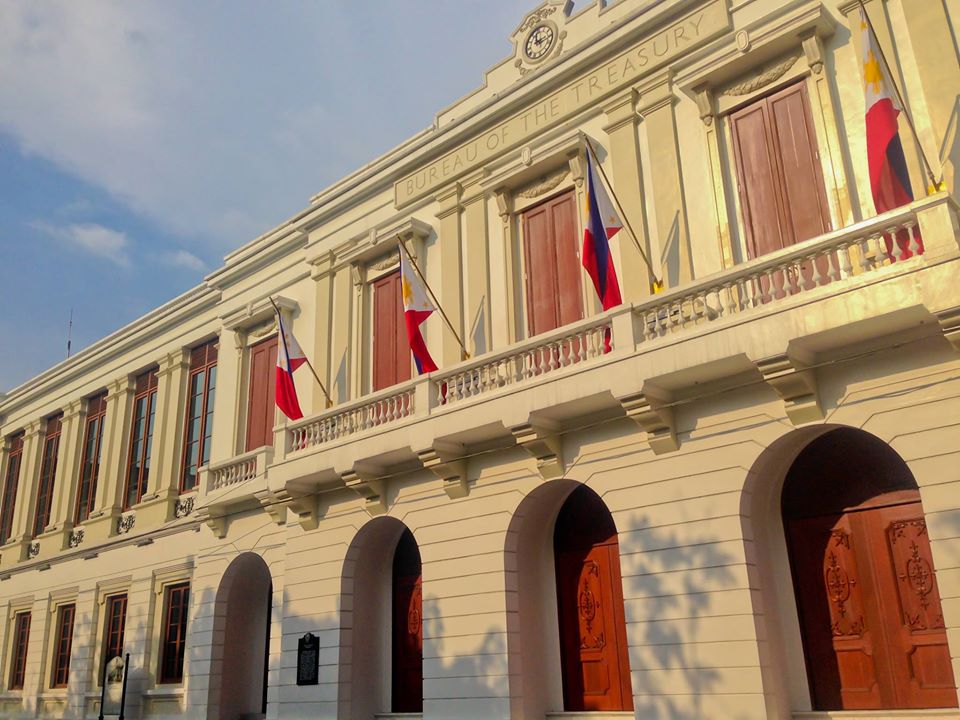
The Ayuntamiento de Manila which houses the Bureau of the Treasury (From the Facebook account of the bureau)
MANILA, Philippines—With the implementation of the Supreme Court’s Mandanas-Garcia ruling in full swing, the bigger budgets granted to local government units (LGU) at the start of this year bloated the national government’s budget deficit by two-thirds to P23.4 billion.
The Bureau of the Treasury’s (BTr) latest cash operations report released on Thursday (March 17) showed expenditures on public goods and services grew 9.7 percent year-on-year to P301.5 billion last January, outpacing the 6.7-percent increase in tax and non-tax revenues to P278.1 billion.
As such, the fiscal gap remained at a deficit and 66.3-percent larger than the P14.1 billion a year ago. While the government spends on a deficit to finance priority programs and projects, especially in sectors lagging behind like infrastructure, a huge budget deficit puts pressure on meager resources and ramps up borrowings to fill the gap.
In a statement, the BTr partly attributed the faster disbursement growth to the national tax allotment (NTA) releases to LGUs.
The Department of Budget and Management’s (DBM) special allotment release order (Saro) documents had shown that P239.8 billion of the over P959-billion NTA for 2022 was released last Jan. 11 to cover LGUs’ first-quarter shares.
LGUs’ 2022 NTA jumped from P695.49 billion last year, when it was still known as internal revenue allotment (IRA), as the government implemented the high court’s Mandanas-Garcia ruling pegging computation of LGU shares in the national budget on all revenue collected by the Bureau of Customs (BOC) and Bureau of Internal Revenue (BIR).
In the past, LGUs’ IRA only came from BIR collections.
Given the higher budgets, more functions were devolved to LGUs, including local infrastructure, agriculture, social welfare, health care, and livelihood, among others listed by the Local Government Code.
The BTr said primary expenditures net of interest payments — deemed productive spending supportive of economic growth — inched up 3.6 percent year-on-year to P235.9 billion, accounting for nearly fourth-fifths of total January disbursements. Interest payments for outstanding debts jumped by almost two-fifths to P65.6 billion.
On revenues, the national government’s tax take grew 10.5 percent year-on-year to P255.3 billion last January, offsetting the 23.3-percent drop in non-tax collections to P22.8 billion.
The BIR collected P195.8 billion in taxes in January, up 7.5 percent year-on-year but below the P213.6-billion target for the month.
The BOC’s above-goal collection of import duties and other taxes—amounting to P58.3 billion, up 23.4 percent year-on-year—was attributed by the BTr to “improved valuation, intensified enforcement against illegal importation, improved compliance by traders to customs laws, gradual improvement of importation volume, and the government’s effort in ensuring unhampered movement of goods domestically and internationally.”
The BIR and the BOC had been tasked with collecting P2.44 trillion and P679 billion this year.
The DBCC had programmed a P1.65-trillion budget deficit for 2022, equivalent to 7.7 percent of gross domestic product (GDP). The national government must raise over P3.3 trillion in revenues this year to partly fund the P4.95-trillion expenditures supportive of economic recovery. The budget gap will also be financed by borrowings, amounting to P2.2 trillion this year.
Separately, the Department of Finance (DOF) said in a statement on Thursday that the BOC and the BIR’s combined collections of P2.73 trillion exceeded by 1.3 percent their total P2.69-trillion goal in 2021. The BIR collected P2.09 trillion in taxes, while the BOC generated P645.8 billion in import duties and other levies last year.
The take of the country’s two biggest tax-collection agencies last year also rose 9.8 percent from P2.49 trillion in 2020, when the economy fell to its worst annual recession post-war.
“On a per-day basis, the BIR and the BOC’s combined collection averaged around P11.02 billion per day as against its daily collection target of P10.88 billion” last year, the DOF said.